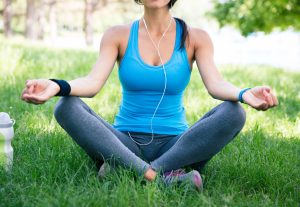We all know stress causes a fight or flight response. Within the sympathetic nervous system it awakens the body through various increases in adrenaline to prepare the body for action. Increase in heart rate, muscle tension, blood pressure, digestive shutdown and preparation to face struggle emerge within the body. Short term this can save oneself, but long term when facing modern problems that cannot be fled or do not pose physical harm, it can cause issues with health. AIHCP’s Stress Management Consulting Program offers courses and ideas on how to reduce stress and find calm for oneself and others.
It is very important to identify stressors and reduce the negative impact on the body. Knowing how to calm the body is key. There are a variety of ways to calm the body physically, mentally and emotionally. There are also a variety of tools to help calm the body. The key is to reverse the effects of the sympathetic nervous system and return to a state of calm. Of course Meditation is key but not everyone can mediate immediately when stressed. Long term use of meditation can help overall and when the situation occurs, but one needs to have other strategies also to deal with anxiety, fear, stress and worry.

Physically, Power Breathing is an excellent way to help reverse the ill effects of stress. When stressed, individuals breath in short shallow breathes. This reduces oxygen in the blood and also causes anxiety. It is important to take deep breathes that fill the entirety of the lungs, allowing the abdomen to fill and the chest to expand. These short breathes should focus on inhaling and exhaling to promote a more peaceful mind set. This in turn can help the body reverse the effects of the stress response on the blood pressure, muscles and heart.
In addition, Yoga postures, as well as various calm postures can help. Simply by taking a calm postures such as Calm Unfold, that involves a bending to the ground and allowing the arms to dangle, can help reduce stress. Also, when stressed, jaws become stern. By touching the roof of one’s mouth with the tongue, the jaw can be relaxed. Lotus hands and other Eastern postures can also create a sense of calm. By reversing facial expressions associated with stress such as Calm Demeanor, one can also trick the subconscious that correlates these expressions with happier times.
If one notices, when stressed, people speed up things. They talk faster, walk faster, breath faster. Walk slower, speak slower and most importantly by breathing slower, can reverse ill effects of stress. These slow down calm techniques can be very useful.
Some points also help negative energy within the body process through. Acupuncture and EFT tapping are all examples of utilizing points in the body to release negative energy trauma and stress. Self massage points can help reduce tension and stress. Checkbone rubs, Feng Chih (back of skull), Jan Ku (below ankle), Chin Wei (Below breast bone), ear points, wrists, top of head and foot reflexology can all be sensitive points that can relax energy channels and muscles. Aromas such as lavender can also help one find calm physically.
Like meditation, herbs can also play long term keys in helping oneself, but again, these are not immediate fixes like many of the above procedures. Ginseng, Valerian and Chamomile can all play long term helps, as well as a higher alkaline diet.
Individuals can also employ a wide variety gadgets to help reduce stress on the spot. Finger bindings, worry beads, stress balls, music, ionizer, bio feedbacks, self hypnosis and stress balls are all techniques and gadgets on the spot that can help reduce stress.
Mentally and emotionally, individuals can also reduce stress. Stressors for some are not for others. In many ways, some stress is perception as well as how one copes with the particular stress. Individuals with type A personalities which are more aggressive, over-worked, self centered and heavy goal orientated individuals suffer more from stress than Type B personalities. Type B personalities are more laid back and less prone to stress. Neither personality is superior but if one is more one than the other, then difficulties can arise in how work and goals are met. It is important to implement a little of both personalities to truly find success without the high stress.
Most stressed individuals can utilize a variety of mental ways to reduce stress by how they view it. Calm affirmations are on such way. Calm affirmations replace negative words with positive words for each situation. Focus is more on the positive.
In addition, Big Screen Visualization can play a big role in helping a person view a stressful situation. Through the power of imagination and visualization, one can imagine oneself in various situations but with successful outcomes. Another visualization technique is referred to as Stepping in Time. With this visualization, one imagines the problem now then reviews it at a later date, and if it bears any power on that date. This can help one see the true significance of the stressor.
Also, one can similarly try the Ten Year Plan, as well as the Universal Perspective. The Universal Perspective teaches one to visualize oneself from various frames of height, until one only sees the Earth. One can even go farther to the edge of the solar system or galaxy. How important is the stressor at that moment?

Framing is also another useful visualization tactic in which the person can reframe in one’s mind a stressful person or place with comedy. For those who feel they cannot perform these visualizations or avoid the stress, one can offer a Lets Pretend technique. The stressed person then pretends they are not stressed. Sure enough, soon the person discovers he or she is not stressed
Other Type A worriers need strategies. Permission to let loose, or be a Type B person for an hour, or permission to say no, or permission to play strategies can help them unwind. In addition, giving one a worry free spot, whether at home or work to go to. This type of re-programming is based on the environment. Places, music, or scents that are associated with stress are stressful. Opposite, places, music and scents associated with peace are not stressful. One can trick the subconscious to feel safer and relaxed by sitting in area more peaceful, or listening to a song associated with a good moment.
Worry lists can also help. One can departmentalize the worry and assign it an appropriate time. This closely resembles the concept of worry dolls. In addition, sometimes, disconnect is critical. To walk away from the worry itself to eliminate the stressor and the physical issues associated.
This is a but a small sample on ways to elicit the calm response within the body. There are many other ways, especially in the text Instant Calm found with SM560.
If you would like to learn more about reducing stress and becoming certified in Stress Management Consulting, then please review AIHCP’s Stress Management Consulting Program and see if it meets your academic and professional goals. The program is online and independent study and open to qualified professionals looking to become Stress Management Consultants
Resources
Instant Calm by Paul Wilson
